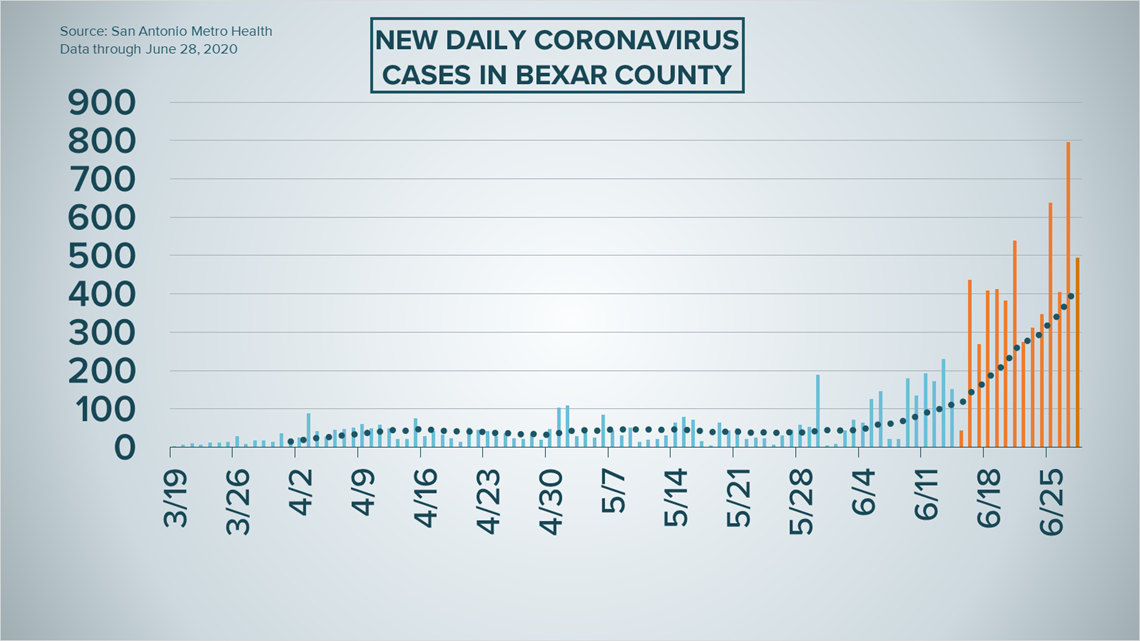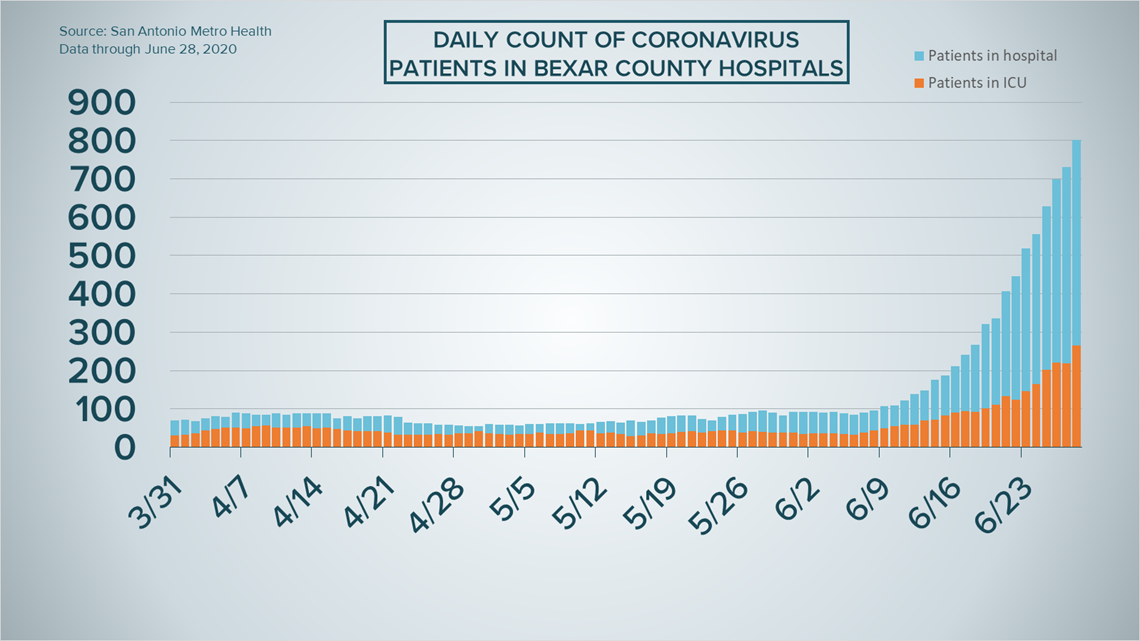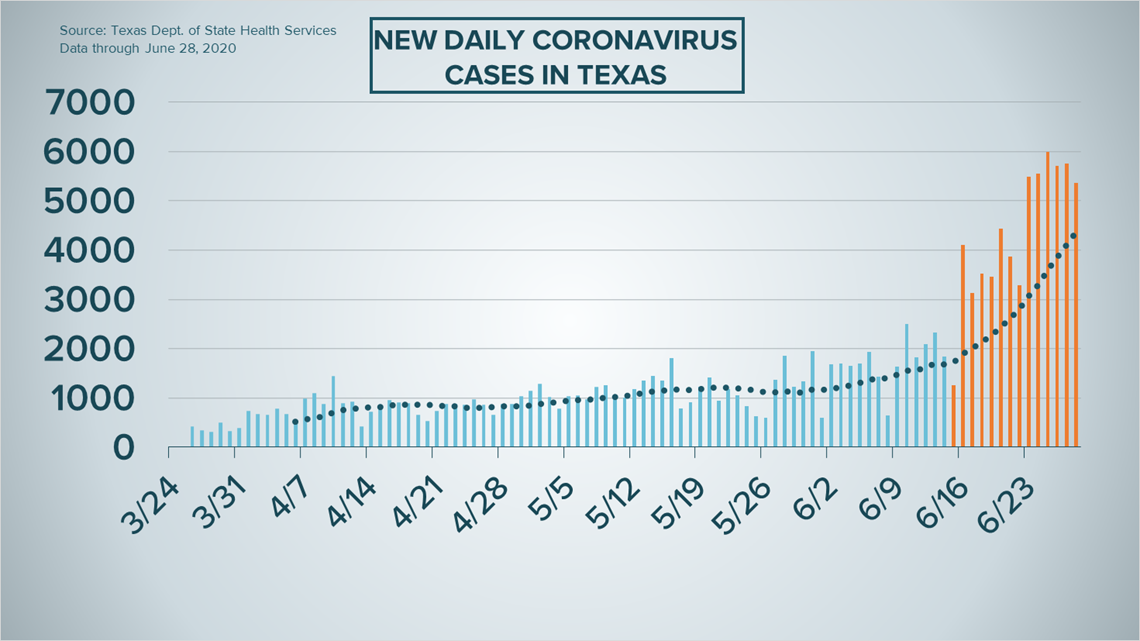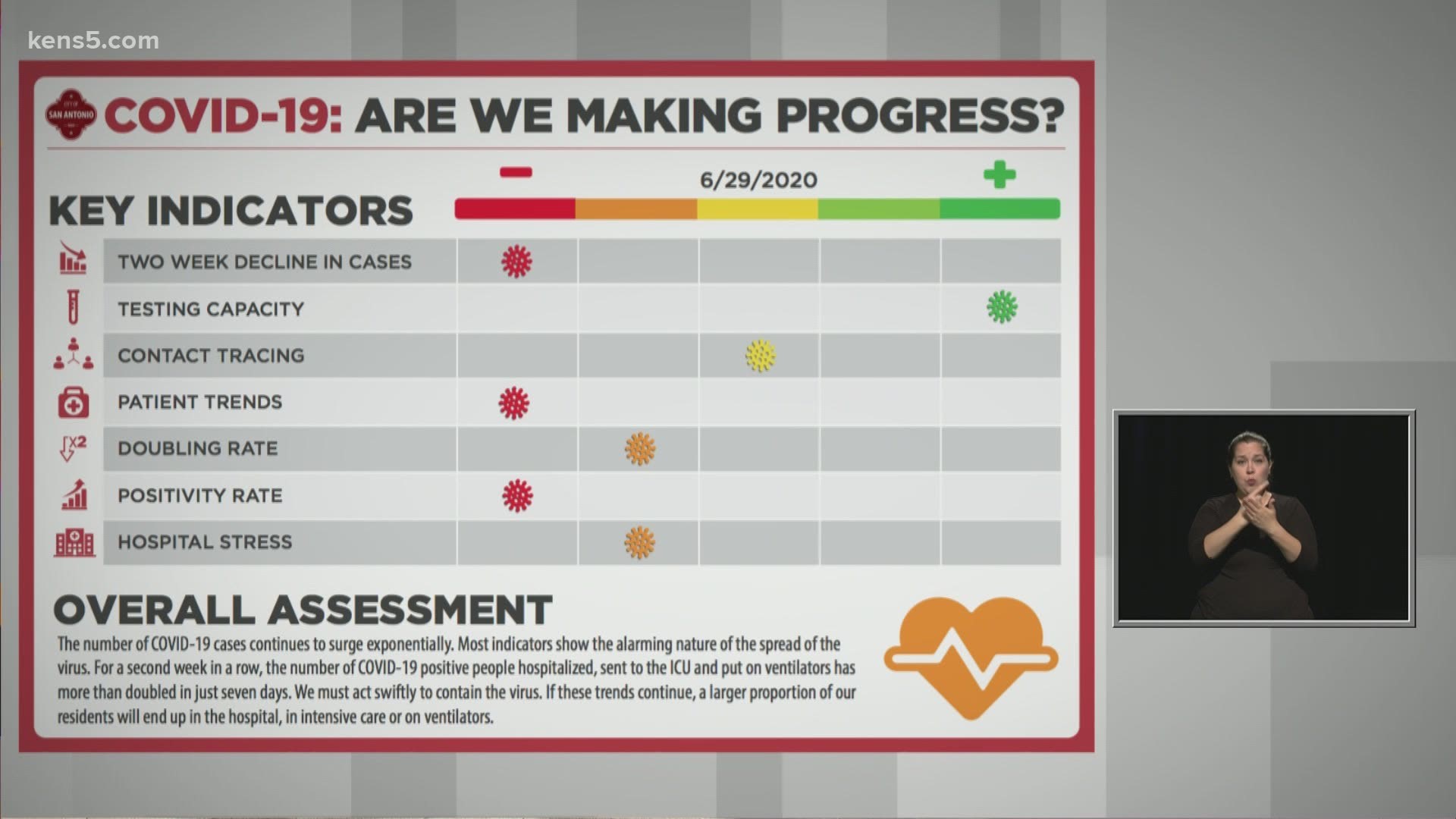SAN ANTONIO — We're tracking the latest numbers from the coronavirus pandemic in San Antonio and across Texas. Here are the latest numbers reported by Bexar and surrounding counties:
- Bexar County: 495 new cases and two additional deaths were reported Sunday. There is a total of 10,147 cases and 109 fatalities in the county. 802 patients are in local hospitals.
- Comal County: The county reported 35 new confirmed and 11 probable cases on Saturday, for a total of 598. Seven people have died in the county, while 249 have recovered. The positivity rate is now 9.72%.
- Hays County: 117 new cases reported Sunday, bringing the total to 2,586 cases and six fatalities in the county. 50% of the county's confirmed cases are people between the ages of 20 and 29.
Here are Sunday's full numbers. Bexar County reports them daily at 7 p.m.:
How Bexar County is trending:
We're tracking how many coronavirus cases are confirmed in Bexar County each day from the time San Antonio Metro Health began reporting cases more than two months ago. Graphing those daily case numbers along a 14-day moving average provides an accurate picture of the curve in the San Antonio area and the direction we're heading amid the coronavirus.
Metro Health reported 495 newly confirmed cases of the coronavirus in Bexar County Sunday, bringing the total past 10,000. Two more virus-related deaths were also reported, bringing the total to 109 fatalities.


Meanwhile, 802 COVID-19-positive patients are in local hospitals—another high-water mark for Bexar County. This is a jump of 72 from Saturday, marking 21 days in a row with a new record high. The number of coronavirus patients in San Antonio area hospitals has risen by 835% in the last three weeks.
There are currently 265 people under intensive care in area hospitals, another record high. 138 patients are currently on ventilators, up from 29 just two weeks ago.


Coronavirus in Texas
Texas reported 5,747 new COVID-19 cases Sunday. There have been at least 5,000 new cases reported each day for the last six days. Before then, there were zero such days for the state. Over 37,000 new cases have been confirmed in the state in the past week.


The number of current patients in Texas hospitals actually went down slightly on Sunday after 16 consecutive days with record highs reported. 5,497 Texans are currently in the hospitals.
Latest Coronavirus Headlines
- Pence, Birx appeal 'to every Texan' to wear a mask after state's positivity rate triples in one month
- Coronavirus global death toll passes 500,000; over 10 million cases
- #WhyIWearAMaskSA | KENS 5 viewers explain why they wear a mask
- New bar shutdown, restaurant capacity reduction hard to swallow for owners
- San Antonio banning gatherings of more than 10 in city spaces; Nirenberg calls latest Texas orders 'a step in the right direction'
- Texas Republicans move forward with plans for an indoor convention in Houston, the state's biggest coronavirus hot spot
- Inside Texas Politics: Speaker Bonnen says, 'not wearing a mask is keeping businesses from being fully open'
- Bars ordered to close, restaurants to reduce to 50%, outdoor gatherings limited: Gov. Abbott
Coronavirus symptoms
The symptoms of coronavirus can be similar to the flu or a bad cold. Symptoms include fever or chills, cough, shortness of breath or difficulty breathing, fatigue, muscle or body aches, headache, new loss of taste or smell sore throat, congestion or runny nose, nausea or vomiting and diarrhea, according to the Centers for Disease Control.
Most healthy people will have mild symptoms. A study of more than 72,000 patients by the Centers for Disease Control in China showed 80 percent of the cases there were mild.
But infections can cause pneumonia, severe acute respiratory syndrome, kidney failure, and even death, according to the World Health Organization. Older people with underlying health conditions are most at risk.
On June 25, the CDC expanded the list of groups at a higher risk of severe illness due to coronavirus.
Experts determined there was consistent evidence these conditions increase a person's risk, regardless of age:
- Chronic kidney disease
- COPD (chronic obstructive pulmonary disease)
- Obesity (BMI of 30 or higher)
- Immunocompromised state (weakened immune system) from solid organ transplant
- Serious heart conditions, such as heart failure, coronary artery disease, or cardiomyopathies
- Sickle cell disease
- Type 2 diabetes
The CDC believes symptoms may appear anywhere from two to 14 days after being exposed.
Human coronaviruses are usually spread...
- Between people who are in close contact with one another (within about 6 feet).
- Through respiratory droplets produced when an infected person coughs, sneezes or talks. These droplets can land in the mouths or noses of people who are nearby or possibly be inhaled into the lungs.
- Some recent studies have suggested that COVID-19 may be spread by people who are not showing symptoms.
Help stop the spread of coronavirus
- Stay home when you are sick.
- Eat and sleep separately from your family members
- Use different utensils and dishes
- Cover your cough or sneeze with your arm, not your hand.
- If you use a tissue, throw it in the trash.
Lower your risk
- Wash your hands often with soap and water for at least 20 seconds. If soap and water are not available, use an alcohol-based hand sanitizer.
- Avoid touching your eyes, nose, and mouth with unwashed hands.
- Avoid close contact with people who are sick.
- Clean and disinfect frequently touched objects and surfaces.
- The CDC recommends wearing a mask or cloth face covering if you have to be out due to an essential service or essential activity such as going to the grocery store.
- If you are 60 or over and have an underlying health condition such as cardiovascular disease, diabetes or respiratory illnesses like asthma or COPD, the World Health Organization advises you to try to avoid crowds or places where you might interact with people who are sick.

